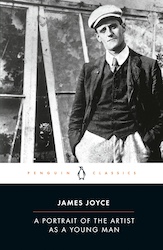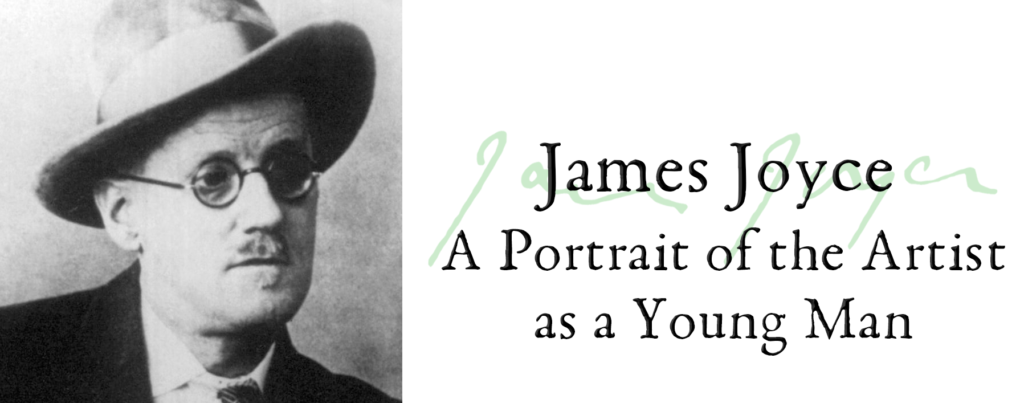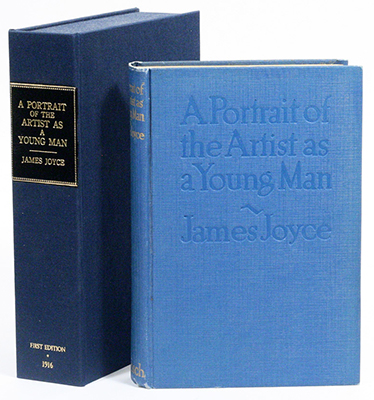Joyce Works: “A Portrait of the Artist as a Young Man”
- At May 06, 2022
- By Great Quail
- In Joyce
 0
0
“I will not serve that in which I no longer believe whether it call itself home, my fatherland or my church: and I will try to express myself in some mode of life or art as freely as I can and as wholly as I can, using for my defense the only arms I allow myself to use, silence, exile, and cunning.”
—James Joyce, “A Portrait of the Artist as a Young Man”
A Portrait of the Artist as a Young Man
A Portrait of the Artist as a Young Man
By James Joyce
B.W. Huebsch, 1916

A Portrait of the Artist as a Young Man
By James Joyce
Penguin Classics, 2003
A Portrait of the Artist as a Young Man is James Joyce’s first novel, a semi-autobiographical tale about a young Irish writer named Stephen Dedalus. Divided into five chapters, Portrait follows Stephen’s life from childhood through the first flush of adulthood. As Stephen matures through various conflicts with his parents and his Jesuit upbringing, he rebels against his family, his religion, and his nation. He eventually seeks self-exile in Paris and begins his life as a writer.
What distinguishes Portrait from the average “coming of age” story is the way Joyce tells his story. In Portrait, Joyce begins experimenting with “stream of consciousness” narrative, a prose style that would come to full flower in Ulysses. Rather than relating the story objectively to the reader, the narrative itself provides a window into Stephen’s consciousness, and the entire world of the novel is exposed through that single aperture. Joyce’s prose evolves with Stephen’s intellectual development, whether imitating the childlike simplicity of his earliest memories or the bombastic self-awareness of his precocious adolescence. Reflecting Stephen’s mood at every turn, the narrative swoops when Stephen is high, and crashes when he’s brought low. It congeals in the muddle of an endless Jesuit lecture, but skips along merrily when chasing the thoughts of an awakening poet.
This kind of narrative is not only exciting to read, it affects the reader on a subconscious level. In most novels, the prose style remains essentially consistent. This allows the reader to generate a subtle image of the author, a ghostly persona haunting the space between the text and the reader’s comprehension of the text. (In literary theory, this is known as the “implied author.”) In Portrait, Joyce begins the process of removing himself from his work. As Stephen remarks, “the artist, like the God of the creation, remains within or behind or beyond or above his handiwork, invisible, refined out of existence, indifferent, paring his fingernails.” Portrait attempts to banish the author and immerse the reader wholly in the protagonist’s consciousness. The narrative is never expository, ironic, or judgmental; it’s not willing to assist the reader in any way. Lacking a privileged position outside the narrative, we understand the world of Portrait only through Stephen himself—his thoughts, his feelings, his reactions, his world.
Advice for the First-Time Reader
A Portrait of the Artists as a Young Man is a Bildungsroman; a type of book that traces the moral and intellectual development of its youthful protagonist. In this sense, Portrait belongs to a tradition which includes works like Candide, Wilhelm Meister’s Apprenticeship, Jane Eyre, David Copperfield, Demian, and Cather In the Rye. Like many such books, the ideal time to read Portrait is during one’s youth—Stephen’s adolescent moods tend to resonate more powerfully when shared by the reader! Having said that, one can hardly advise a first-time reader to “be younger!”—but it’s something to keep in mind when buying birthday presents for precocious teenagers.
Which isn’t to say that Portrait should be avoided by jaded adults. It’s a beautifully written book, containing some of Joyce’s most exuberant passages, and the notorious “lecture on eternity” has inspired similar scenes in dozens of movies and books. Another attractive feature of Portrait is its accessibility. While remaining a canonical work of Modernism, Portrait is no Ulysses—it’s short, coherent, and easy to read. Once you get past “Baby tuckoo met a moocow,” Joyce’s experimental prose settles into a lucid, stream-of-consciousness style that’s not unfamiliar to contemporary readers.
Continuity
There’s much to be said for reading Joyce chronologically. Not only does this allow a reader to grow accustomed to his evolving prose style, it reveals his considerable talents as a world-builder. All of Joyce’s books are related; set in a single, fictionalized Dublin populated by recurring characters and themes. Each book is set after the previous book, and often contains references to things that occurred in previous stories. While you don’t have to read Dubliners to enjoy Portrait, the two books occupy the same literary universe, and are linked by Ulysses, which includes characters from both. Indeed, Stephen Dedalus is one of the main characters in Ulysses, and Portrait is an important precursor to Joyce’s sprawling masterpiece.
Allusions
James Joyce is famous—some would say infamous—for including countless “real-world” allusions in his books. The stories of Dubliners immerse the reader in nineteenth-century Ireland and its politics. Although Portrait doesn’t aspire to the convoluted density of Ulysses, it contains more contemporary references and obscure passages than Dubliners. Real-world locations, political figures, fragments of other languages, religious allusions, advertisements, popular songs, and newsworthy events are generously hopped into a heady brew which can feel occasionally disorienting. A good annotated guide can bring sense to it all; but this is only a suggestion. If you can live without having every phrase of “dog-Latin” translated, and each historical figure placed in context, Portrait can be read and thoroughly enjoyed without a guidebook.
Nevertheless, like when reading Dubliners, it’s still useful to brush up on contemporary Irish politics, particularly Ireland’s relationship to England and the Roman Catholic church. Of particular political importance is the figure of Charles Stewart Parnell, an Irish MP who devoted himself to land reform, working at odds with the British until his adulterous fall from grace. Parnell casts a long shadow over Joyce’s work, from Dubliners to Finnegans Wake.
When it comes time to consult a guidebook, it’s hard to beat Don Gifford’s Joyce* Annotated. This easy-to-use book offers thousands of annotations for Joyce’s text, glossing everything from snippets of French to obscure slang words. Not only that, it contains annotations for both Dubliners and Portrait.
Brazen Head Resources
Portrait Criticism — A list of annotations, guides, and criticism published about A Portrait of the Artist as a Young Man.
Joyce Works:
[Main Page | Dubliners | A Portrait of the Artist as a Young Man | Ulysses | Finnegans Wake | Poetry | Exiles | Other Works]
Author: Allen B. Ruch
Last Modified: 12 June 2024
Main Joyce Page: The Brazen Head
Contact: quail(at)shipwrecklibrary(dot)com


